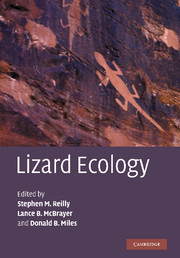Book contents
- Frontmatter
- Contents
- List of contributors
- Preface
- Historical introduction: on widely foraging for Kalahari lizards
- I Organismal patterns of variation with foraging mode
- II Environmental influences on foraging mode
- 12 The foraging biology of the Gekkota: life in the middle
- 13 Foraging mode in the African cordylids and plasticity of foraging behavior in Platysaurus broadleyi
- 14 Interactions between habitat use, behavior, and the trophic niche of lacertid lizards
- 15 Food acquisition modes and habitat use in lizards: questions from an integrative perspective
- 16 The evolution of foraging behavior in the Galápagos marine iguana: natural and sexual selection on body size drives ecological, morphological, and behavioral specialization
- 17 The evolution of the foraging mode paradigm in lizard ecology
- Index
- References
13 - Foraging mode in the African cordylids and plasticity of foraging behavior in Platysaurus broadleyi
Published online by Cambridge University Press: 04 August 2010
- Frontmatter
- Contents
- List of contributors
- Preface
- Historical introduction: on widely foraging for Kalahari lizards
- I Organismal patterns of variation with foraging mode
- II Environmental influences on foraging mode
- 12 The foraging biology of the Gekkota: life in the middle
- 13 Foraging mode in the African cordylids and plasticity of foraging behavior in Platysaurus broadleyi
- 14 Interactions between habitat use, behavior, and the trophic niche of lacertid lizards
- 15 Food acquisition modes and habitat use in lizards: questions from an integrative perspective
- 16 The evolution of foraging behavior in the Galápagos marine iguana: natural and sexual selection on body size drives ecological, morphological, and behavioral specialization
- 17 The evolution of the foraging mode paradigm in lizard ecology
- Index
- References
Summary
Introduction
Understanding the evolution of key life history traits frequently involves searching for broad-scale patterns among diverse organisms (see, for example, Vitt et al., 2003). When consistent patterns emerge, particularly among members of multiple clades, our understanding of how suites of traits co-evolve is improved. In the process, new hypotheses are generated, allowing further testing of patterns and the mechanisms that generate them. The simplified goal of this book is to disentangle the evolution of foraging mode within a major vertebrate lineage: lizards. In particular, we wish to understand the relationship between foraging mode and a suite of co-evolved characters. Fundamental to lizard foraging theory is the tenet that foraging mode has greatly constrained (or shaped) the evolution of certain traits, including aspects of morphology and physiology. For example, ambush foragers are often tank-like and have a high relative clutch mass, relatively slow sprint speed and lower metabolic rate than active foragers, which are slender, relatively fast, and with lower relative clutch mass (Huey and Pianka, 1981; see references in Greeff and Whiting, 2000). More recently, there is accumulating evidence that although foraging mode has had a profound influence on aspects of lizard biology, foraging mode is deeply rooted in history (phylogeny) and only one of many traits explaining current lizard diversity (Perry, 1999; Vitt et al., 2003). Lizard foraging mode is also remarkably stable within entire clades (e.g. families) of lizards (Cooper, 1994, 1995).
- Type
- Chapter
- Information
- Lizard Ecology , pp. 405 - 426Publisher: Cambridge University PressPrint publication year: 2007
References
- 5
- Cited by



